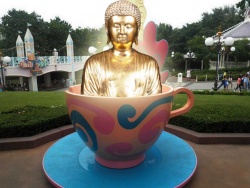Difference between revisions of "Self-existing Perfection"
Jump to navigation
Jump to search
| (4 intermediate revisions by the same user not shown) | |||
| Line 7: | Line 7: | ||
[[Erik Pema Kunsang|Kunsang]] (1987, 2007: p.90) provides the following summary of this [[Dzogchen]] [[tantra]] and foregrounds the premier motif of the [[four empowerments]]: | [[Erik Pema Kunsang|Kunsang]] (1987, 2007: p.90) provides the following summary of this [[Dzogchen]] [[tantra]] and foregrounds the premier motif of the [[four empowerments]]: | ||
| − | + | "...[it] teaches how to prepare to be a suitable recipient of the teachings by means of the four [[empowerment]]s." | |
| − | |||
| + | {{Seealso|see=Seventeen tantras}} | ||
Latest revision as of 13:22, 26 November 2019
Self-existing Perfection (Tibetan: རྫོགས་པ་རང་བྱུང, Tib. dzogpa rangjung Wylie: rdzogs pa rang byung) is one of the Seventeen tantras of Dzogchen Upadesha.
Kunsang (1987, 2007: p.90) provides the following summary of this Dzogchen tantra and foregrounds the premier motif of the four empowerments:
"...[it] teaches how to prepare to be a suitable recipient of the teachings by means of the four empowerments."
- See also : Seventeen tantras
- See also : Seventeen tantras
